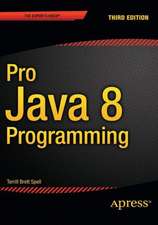Scala Design Patterns: Patterns for Practical Reuse and Design
Autor John Hunten Limba Engleză Paperback – 27 aug 2016
Scala Design Patterns looks at how code reuse can be successfully achieved in Scala. A major aspect of this is the reinterpretation of the original Gang of Four design patterns in terms of Scala and its language structures (that is the use of Traits, Classes, Objects and Functions). It includes an exploration of functional design patterns and considers how these can be interpreted in Scala's uniquely hybrid style.
A key aspect of the book is the many code examples that accompany each design pattern, allowing the reader to understand not just the design pattern but also to explore powerful and flexible Scala language features. Including numerous source code examples, this book will be of value to professionals and practitioners working in the field of software engineering.
| Toate formatele și edițiile | Preț | Express |
|---|---|---|
| Paperback (1) | 642.62 lei 6-8 săpt. | |
| Springer International Publishing – 27 aug 2016 | 642.62 lei 6-8 săpt. | |
| Hardback (1) | 654.55 lei 6-8 săpt. | |
| Springer International Publishing – 6 dec 2013 | 654.55 lei 6-8 săpt. |
Preț: 642.62 lei
Preț vechi: 803.28 lei
-20% Nou
Puncte Express: 964
Preț estimativ în valută:
122.96€ • 128.39$ • 101.54£
122.96€ • 128.39$ • 101.54£
Carte tipărită la comandă
Livrare economică 15-29 aprilie
Preluare comenzi: 021 569.72.76
Specificații
ISBN-13: 9783319349725
ISBN-10: 3319349724
Pagini: 349
Ilustrații: XXII, 327 p. 90 illus., 49 illus. in color.
Dimensiuni: 155 x 235 x 19 mm
Greutate: 0.49 kg
Ediția:Softcover reprint of the original 1st ed. 2013
Editura: Springer International Publishing
Colecția Springer
Locul publicării:Cham, Switzerland
ISBN-10: 3319349724
Pagini: 349
Ilustrații: XXII, 327 p. 90 illus., 49 illus. in color.
Dimensiuni: 155 x 235 x 19 mm
Greutate: 0.49 kg
Ediția:Softcover reprint of the original 1st ed. 2013
Editura: Springer International Publishing
Colecția Springer
Locul publicării:Cham, Switzerland
Cuprins
Author’s Note.- Part I – Introduction.- Introduction.- Design Patterns.- UML and Scala.- Part II – Fundamental Patterns.- Immutability.- Singleton.- Marker Trait.- Delegation.- Part III – Code Reuse Patterns.- Lazy Parameters.- Partially Applied Functions.- Trait Based Template Operation.- Stackable Traits.- Currying and Code Reuse.- Cake Pattern.- Structural Injection.- Implicit Injection Pattern.- Part IV – Gang of Four Patterns.- Gang of Four Design Patterns.- Gang of Four Patterns Catalogs.- Factory Operation.- Abstract Factory Pattern.- Builder.- Adapter Pattern.- Decorator.- Facade.- Flyweight.- Proxy.- Filter.- Bridge.- Chain of Responsibility.- Command.- Strategy.- Mediator.- Observer.- State.- Visitor.- Memento.- Part V – Functional Design Patterns.- Functor.- Applicative Functor.- Monoid Pattern.- Monad Pattern.- Foldable.- Zipper.- Lens Pattern.- View Pattern.- Arrow Pattern.
Textul de pe ultima copertă
Scala is a new and exciting programming language that is a hybrid between object oriented languages such as Java and functional languages such as Haskell. As such it has its own programming idioms and development styles.
Scala Design Patterns looks at how code reuse can be successfully achieved in Scala. A major aspect of this is the reinterpretation of the original Gang of Four design patterns in terms of Scala and its language structures (that is the use of Traits, Classes, Objects and Functions). It includes an exploration of functional design patterns and considers how these can be interpreted in Scala's uniquely hybrid style.
A key aspect of the book is the many code examples that accompany each design pattern, allowing the reader to understand not just the design pattern but also to explore powerful and flexible Scala language features. Including numerous source code examples, this book will be of value to professionals and practitioners working in the field of software engineering.
Scala Design Patterns looks at how code reuse can be successfully achieved in Scala. A major aspect of this is the reinterpretation of the original Gang of Four design patterns in terms of Scala and its language structures (that is the use of Traits, Classes, Objects and Functions). It includes an exploration of functional design patterns and considers how these can be interpreted in Scala's uniquely hybrid style.
A key aspect of the book is the many code examples that accompany each design pattern, allowing the reader to understand not just the design pattern but also to explore powerful and flexible Scala language features. Including numerous source code examples, this book will be of value to professionals and practitioners working in the field of software engineering.
Caracteristici
Interprets purely Functional Patterns in terms of design patterns for use in Scala's hybrid style Illustrates how to maximise code reuse through functions, currying, and dependency injection using Scala language facilities Presents the Gang of Four Design Patterns using Scala language structures (which differ significantly from languages such as Java with the inclusion of Functions as first class language elements)

















![Her Master's Voice. Concert Register and Discography of Dame Elisabeth Schwarzkopf [Third Edition, 2006]](https://i1.books-express.ro/bt/9781901395211/her-master-s-voice-concert-register-and-discography-of-dame-elisabeth-schwarzkopf-third-edition-2006.jpg)